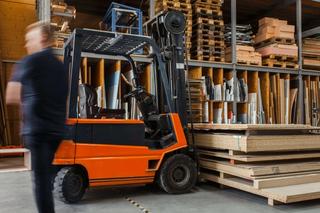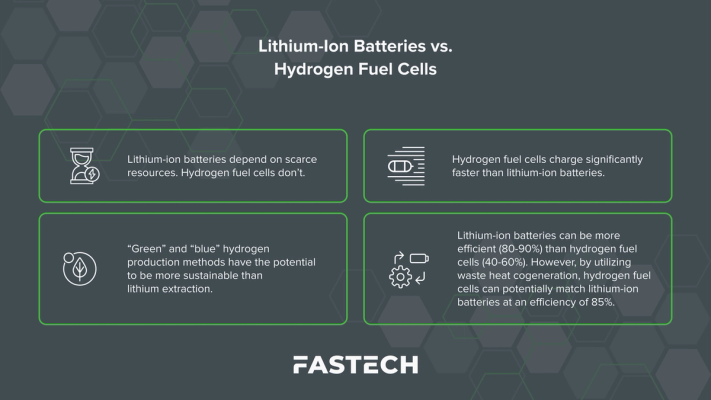Exploring the Impact of Hydrogen Fuel Cells in Forklifts

The US’s hydrogen strategy is prioritizing a greater adoption of hydrogen in strategic, high-impact use cases. Recent innovations in hydrogen fuel cells have driven much of its applicability across several sectors and applications. One notable example is its use in forklifts, which are essential to a wide range of industrial contexts.
Given how ubiquitous forklifts are and how much energy is required for each one, utilizing hydrogen instead of traditional internal combustion engines (ICE) to power them makes an outsized positive impact on the environment.
What’s even more exciting is that hydrogen provides this sustainable benefit without sacrificing performance. In fact, it’s the other way around.
The Emergence of Hydrogen Fuel Cells
Hydrogen fuel cells are devices that leverage chemical reactions to produce electricity. They function similarly to batteries; hydrogen molecules are broken down into their component parts, creating a flow of electricity (from protons) as well as heat and water (from electrons).
While hydrogen fuel might seem new and revolutionary, the underlying technology was being tinkered with as early as 1806, per the World Intellectual Property Organization (WIPO). Cars powered by hydrogen (and oxygen) were invented shortly thereafter, and hydrogen fuel cells debuted in 1842, long before gas engines emerged in 1885. However, hydrogen fuel cells were not taken seriously as a viable option for mass-produced consumer vehicles until around 2003.
Two decades later, one of the most exciting new hydrogen applications is in heavy industrial use cases. Toyota's hydrogen-powered forklifts are growing in popularity among manufacturers because of their lower maintenance requirements and positive environmental impact.
Hydrogen Fuel Cells vs. Lithium-Ion Batteries

Hydrogen is not the only alternative to traditional combustion engines in forklifts. Another option is battery power through lithium-ion. Toyota’s Material Handling division notes that lithium-ion offers many of the same benefits as hydrogen fuel cells. In addition, lithium-ion solutions do not have the same infrastructure requirements as hydrogen, which is often its main drawback.
But Power Magazine’s comparison of lithium-ion batteries and hydrogen fuel highlights how:
- Lithium-ion batteries depend on scarce resources, whereas hydrogen fuel cells don’t.
- While “black” hydrogen production is coal-intensive, there is greater potential for sustainability in “green” and “blue” hydrogen production than in lithium extraction.
- Hydrogen fuel cells charge significantly faster than lithium-ion batteries.
- Lithium-ion batteries can be more efficient (80-90%) than hydrogen fuel cells (40-60%), but they can be configured to the same efficiency (85%) with waste heat cogeneration.
What this means in practice is that although lithium-ion is a strong alternative to ICE, the unique properties of hydrogen make it singularly apt for fueling consumer-grade and industrial vehicles.
The Application of Hydrogen Fuel Cells
Aside from the many benefits associated with hydrogen fuel and its efficiency, another boon is how simple it is to apply across heavy industrial contexts. A common refrain among satisfied warehouses and others is how surprisingly easy it is to switch to hydrogen fuel cell power.
Implementing hydrogen fuel cell forklifts means accounting for a handful of essentials, such as:
- Power supply – You need to have a supply of hydrogen fuel stored on-premises or in an easily accessible location, which also requires establishing relationships with suppliers.
- Fuel cells – Vehicles must also be prepared for hydrogen fuel cells, which may require purchasing new equipment or working with your supplier to convert your existing forklift trucks.
- Charging station – New or converted dedicated charging stations will need to be built for hydrogen fuel cell replenishment, along with top-ups for lithium-ion reserve batteries (if using in combination).
As noted above, the logistics of hydrogen distribution are a common obstacle to the broader adoption of hydrogen fuel if you’re not working with a dedicated partner. Getting hydrogen to a facility, at scale, may be the most challenging part of the operation.
However, recent developments like the Biden Administration’s Hydrogen Hubs policy figure to mitigate this difficulty. Over $7 billion in public funding and far greater private resources are being dedicated to building sustainable hydrogen infrastructure, making access easier.
Future Prospects of Industrial Hydrogen Use
Moving forward, hydrogen fuel should only continue to grow in popularity with manufacturers, shippers, and other industrial stakeholders. Governmental strategies in the US and elsewhere are incentivizing strategic investments in needed infrastructure, and forward-thinking enterprises are taking advantage of the inherently efficient fuel source.
For example, consider the recent development behind hydrogen-powered forklifts in Amazon fulfillment centers. After installing a 1MW proton exchange membrane (PEM) electrolyser in December 2023, Amazon has enabled the seamless delivery of green, liquid hydrogen to a fleet of 225 hydrogen forklifts in one fulfillment center. This continues a growing trend: To date, Amazon has deployed 17,000 fuel cells across forklifts in 80 fulfillment centers.
And this is only the beginning. With the right infrastructure in place, hydrogen fuel cells can replace most, if not all, energy sources used in even the most high-leverage industrial contexts.
Take Advantage of Efficient, Renewable Energy
There are good reasons Amazon, Toyota, and other industry giants are using hydrogen fuel cells to power their forklifts. This optimizes energy efficiency, increases productivity, and minimizes negative environmental impacts. Plus, it’s only getting easier to implement.
FASTECH is an end-to-end energy solutions provider helping warehouses, fulfillment centers, and other organizations take advantage of sustainable, efficient energy. We’re committed to building sustainable clean energy infrastructure.
Contact us if you’re considering transitioning to renewable energy sources.





